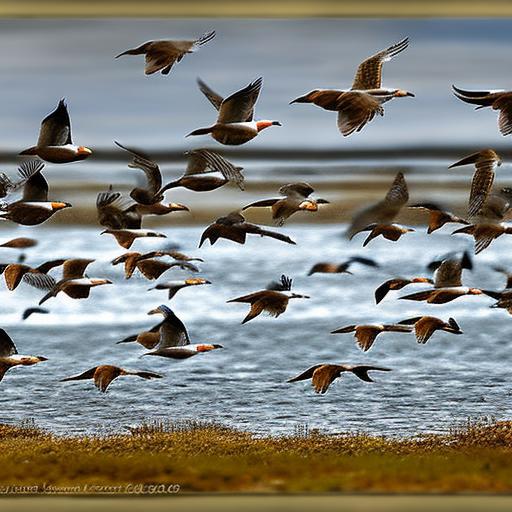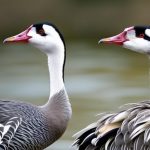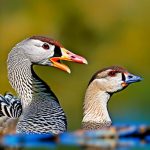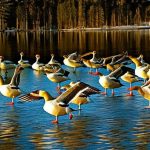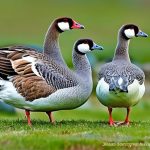Arctic Geese are a group of waterfowl species that inhabit the Arctic regions of North America, Europe, and Asia. They are known for their long migrations, impressive breeding displays, and their ability to adapt to extreme weather conditions. There are several species of Arctic Geese, including the Snow Goose, Canada Goose, and Barnacle Goose.
The Snow Goose is one of the most well-known species of Arctic Geese. It is known for its white plumage and distinctive black wingtips. The Canada Goose is another common species, recognized by its black head and neck with a white chinstrap. The Barnacle Goose is smaller in size and has a black body with white markings on its face and neck.
Key Takeaways
- Arctic geese are migratory birds that breed in the Arctic and winter in more temperate regions.
- Tracking Arctic geese is important for understanding their migration patterns, behavior, and conservation needs.
- Technology such as GPS and satellite tracking is used to monitor Arctic geese movements and behavior.
- Challenges in tracking Arctic geese include the vast distances they cover and the harsh Arctic environment.
- Conservation efforts for Arctic geese include habitat protection, hunting regulations, and monitoring the impacts of climate change.
Migration Patterns of Arctic Geese
Arctic Geese migrate to escape the harsh winter conditions of the Arctic and to find suitable breeding grounds in the summer. They travel long distances, often thousands of miles, to reach their destination. The migration patterns of Arctic Geese vary depending on the species and their breeding grounds.
Some Arctic Geese, such as the Snow Goose, migrate from their breeding grounds in the Arctic tundra to wintering grounds in the southern United States and Mexico. They follow a route known as the Central Flyway, which takes them through the Great Plains of North America.
Other species, like the Canada Goose, have a more diverse migration pattern. Some populations migrate south to warmer regions in the winter, while others stay in their breeding grounds year-round or migrate shorter distances.
Importance of Tracking Arctic Geese
Tracking Arctic Geese is crucial for understanding their behavior and ecology. By tracking their movements, scientists can gather valuable data on their migration patterns, breeding habits, and habitat preferences. This information is essential for conservation efforts and managing their populations effectively.
Tracking also helps researchers identify important stopover sites along their migration routes. These sites provide crucial resources for the geese, such as food and rest areas. By identifying and protecting these sites, conservationists can ensure the survival of Arctic Geese populations.
Technology Used for Tracking Arctic Geese
There are several technologies used for tracking Arctic Geese, ranging from traditional methods to advanced satellite tracking. One common method is the use of leg bands or neck collars with unique identification numbers. These bands allow researchers to track individual birds and gather data on their movements and survival rates.
Another technology used is radio telemetry. This involves attaching small radio transmitters to the geese, which emit signals that can be picked up by receivers on the ground or in aircraft. This allows researchers to track the birds in real-time and gather data on their movements and behavior.
Advancements in tracking technology have also led to the use of satellite tracking. This involves attaching small satellite transmitters to the geese, which transmit signals to satellites orbiting the Earth. These signals provide precise location data, allowing researchers to track the birds’ movements over long distances.
Challenges in Keeping Up with Arctic Geese
Tracking Arctic Geese can be challenging due to several factors. One of the main challenges is the vast distances they travel during migration. This makes it difficult for researchers to keep up with them and gather accurate data on their movements.
Weather conditions also pose a challenge for tracking Arctic Geese. Harsh winter storms and extreme temperatures can make it dangerous for researchers to access their breeding grounds or wintering areas. This can limit the amount of data that can be collected and make it harder to understand their behavior and ecology.
Conservation Efforts for Arctic Geese
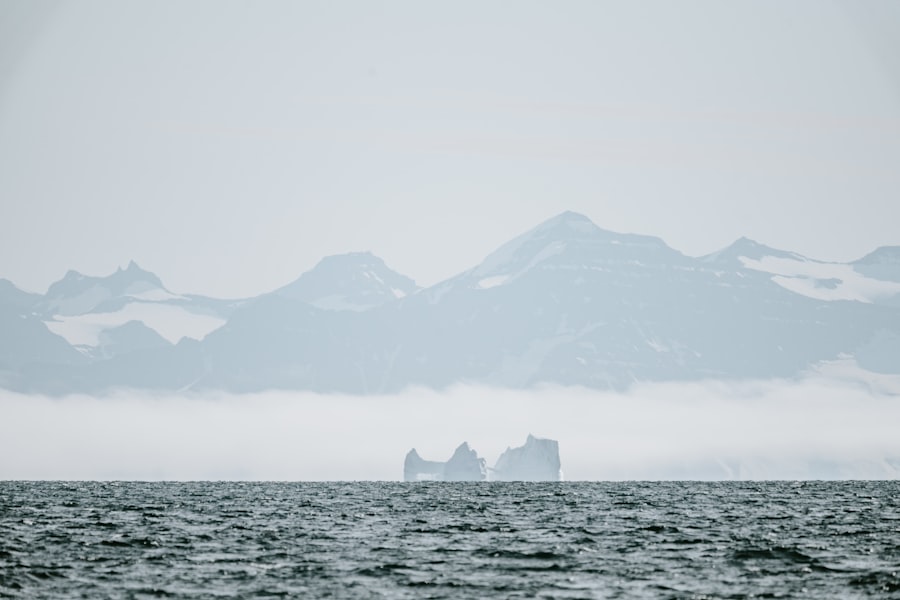
Conservation efforts for Arctic Geese are crucial for maintaining healthy populations and preserving their habitats. These efforts include habitat protection, hunting regulations, and public education.
Habitat protection is essential for ensuring that Arctic Geese have suitable breeding grounds and stopover sites along their migration routes. This involves identifying and preserving important areas, such as wetlands and coastal habitats, that provide the necessary resources for the geese.
Hunting regulations are also in place to manage Arctic Geese populations sustainably. These regulations include setting limits on the number of geese that can be harvested each year and establishing hunting seasons to avoid disrupting breeding and migration patterns.
Public education plays a vital role in conservation efforts for Arctic Geese. By raising awareness about the importance of these birds and their habitats, people can become more engaged in conservation efforts and take actions to protect them.
Impacts of Climate Change on Arctic Geese
Climate change is having a significant impact on Arctic Geese and their habitats. Rising temperatures are causing changes in the timing of their migration and breeding patterns. Warmer winters are also reducing the availability of suitable wintering grounds, forcing some populations to travel longer distances to find suitable habitats.
The loss of sea ice in the Arctic is also affecting Arctic Geese populations. Sea ice provides important feeding grounds for geese during their migration, but as it melts, these areas are becoming less accessible. This can lead to food shortages and reduced survival rates for the geese.
Hunting Regulations for Arctic Geese
Hunting regulations for Arctic Geese are in place to ensure sustainable management of their populations. These regulations vary depending on the species and location, but they generally include limits on bag limits, hunting seasons, and hunting methods.
The purpose of these regulations is to prevent overharvesting and maintain healthy populations of Arctic Geese. By setting limits on the number of geese that can be harvested each year, hunting can be managed in a way that allows populations to recover and thrive.
Economic Significance of Arctic Geese
Arctic Geese have significant economic importance, particularly in regions where they are hunted or attract tourists. Hunting opportunities for Arctic Geese can generate revenue for local communities through license fees, guide services, and equipment sales.
In addition to hunting, Arctic Geese also attract birdwatchers and wildlife enthusiasts who travel to see these magnificent birds in their natural habitats. This can boost local economies through tourism-related activities, such as accommodations, restaurants, and guided tours.
Future Directions in Studying Arctic Geese
The future of studying Arctic Geese lies in continued research and conservation efforts. As climate change continues to impact their habitats and migration patterns, it is crucial to gather more data on their behavior and ecology to develop effective conservation strategies.
Advancements in tracking technology will play a significant role in future research. Satellite tracking, in particular, will provide more precise location data and allow researchers to track the movements of Arctic Geese over long distances.
Furthermore, collaboration between scientists, conservation organizations, and local communities will be essential for the success of future research and conservation efforts. By working together, we can ensure the survival of Arctic Geese populations and protect their habitats for future generations.
If you’re interested in keeping up with arctic geese, you might also find this article on how to care for goslings helpful. It provides valuable insights and tips on raising healthy and happy goslings. Whether you’re a beginner or an experienced goose keeper, this article from Poultry Wizard is a great resource to ensure the well-being of your feathered friends. Check it out here.
FAQs
What are arctic geese?
Arctic geese are a group of waterfowl species that breed in the Arctic regions of North America and Eurasia. They are known for their long migrations and distinctive honking calls.
Why is it important to keep up with arctic geese?
Keeping up with arctic geese is important for several reasons. First, they are an important part of the Arctic ecosystem and play a key role in maintaining the balance of the food chain. Second, they are an indicator species for the health of the Arctic environment, and changes in their populations can signal broader environmental issues. Finally, arctic geese are a valuable resource for subsistence hunters and provide recreational opportunities for birdwatchers and hunters.
How do scientists keep up with arctic geese?
Scientists use a variety of methods to keep up with arctic geese, including satellite tracking, banding, and aerial surveys. Satellite tracking involves attaching small transmitters to individual birds and monitoring their movements remotely. Banding involves attaching small metal or plastic bands to the legs of birds, which can be used to track their movements and survival rates. Aerial surveys involve flying over known breeding and migration areas and counting the number of birds observed.
What are some threats to arctic geese?
Arctic geese face a variety of threats, including habitat loss and degradation, climate change, hunting, and predation. Habitat loss and degradation can result from human activities such as oil and gas development, mining, and agriculture. Climate change can affect the timing and success of breeding and migration, as well as the availability of food and habitat. Hunting and predation can also have significant impacts on arctic goose populations.
What can be done to protect arctic geese?
To protect arctic geese, it is important to address the underlying causes of threats such as habitat loss and climate change. This can involve measures such as reducing greenhouse gas emissions, protecting important habitats, and regulating hunting and predation. In addition, monitoring and research can help to identify emerging threats and inform conservation efforts. Finally, public education and outreach can help to raise awareness about the importance of arctic geese and the need for their protection.
Meet Walter, the feathered-friend fanatic of Florida! Nestled in the sunshine state, Walter struts through life with his feathered companions, clucking his way to happiness. With a coop that’s fancier than a five-star hotel, he’s the Don Juan of the chicken world. When he’s not teaching his hens to do the cha-cha, you’ll find him in a heated debate with his prized rooster, Sir Clucks-a-Lot. Walter’s poultry passion is no yolk; he’s the sunny-side-up guy you never knew you needed in your flock of friends!

